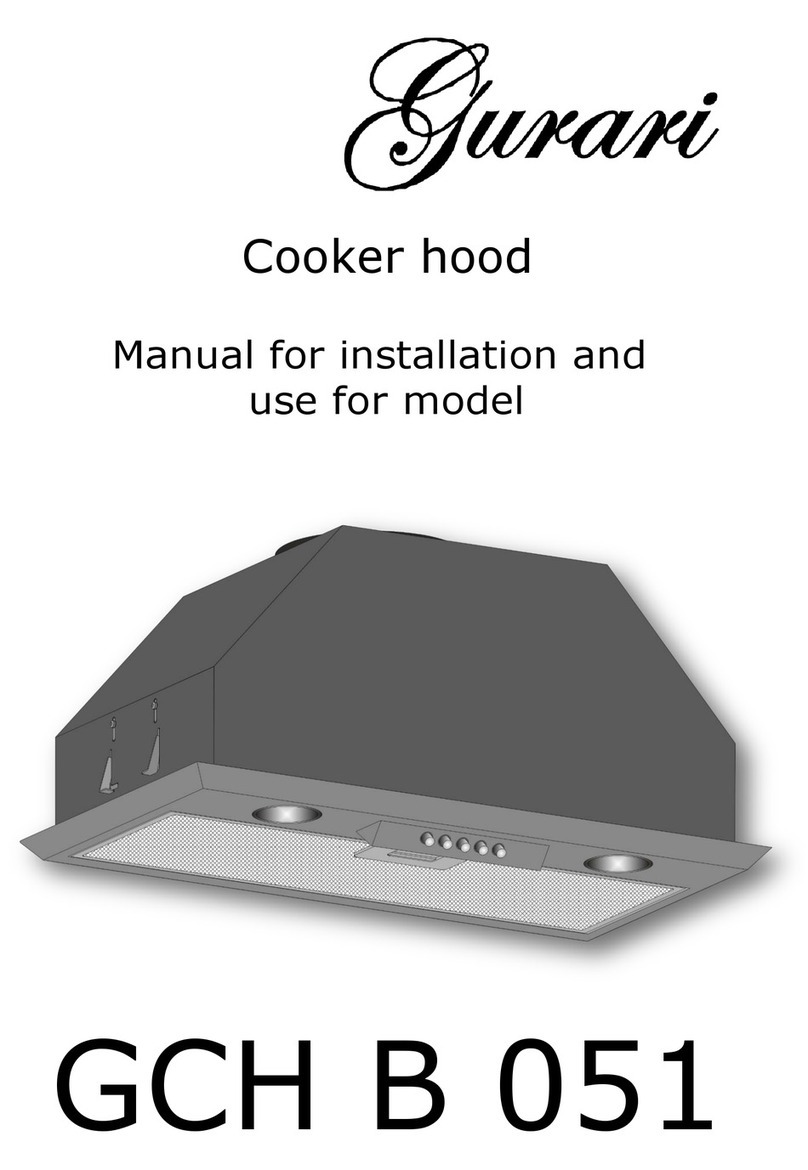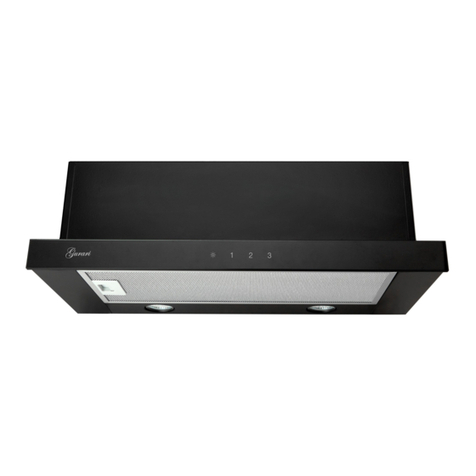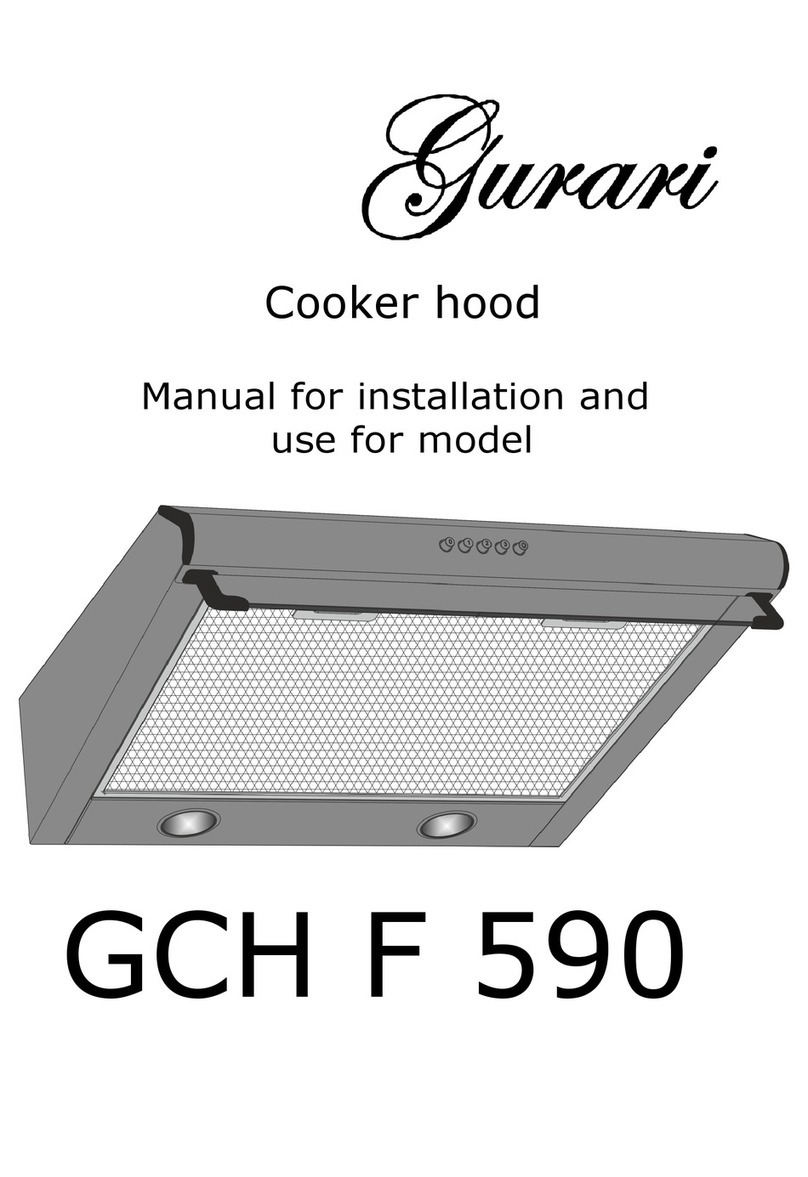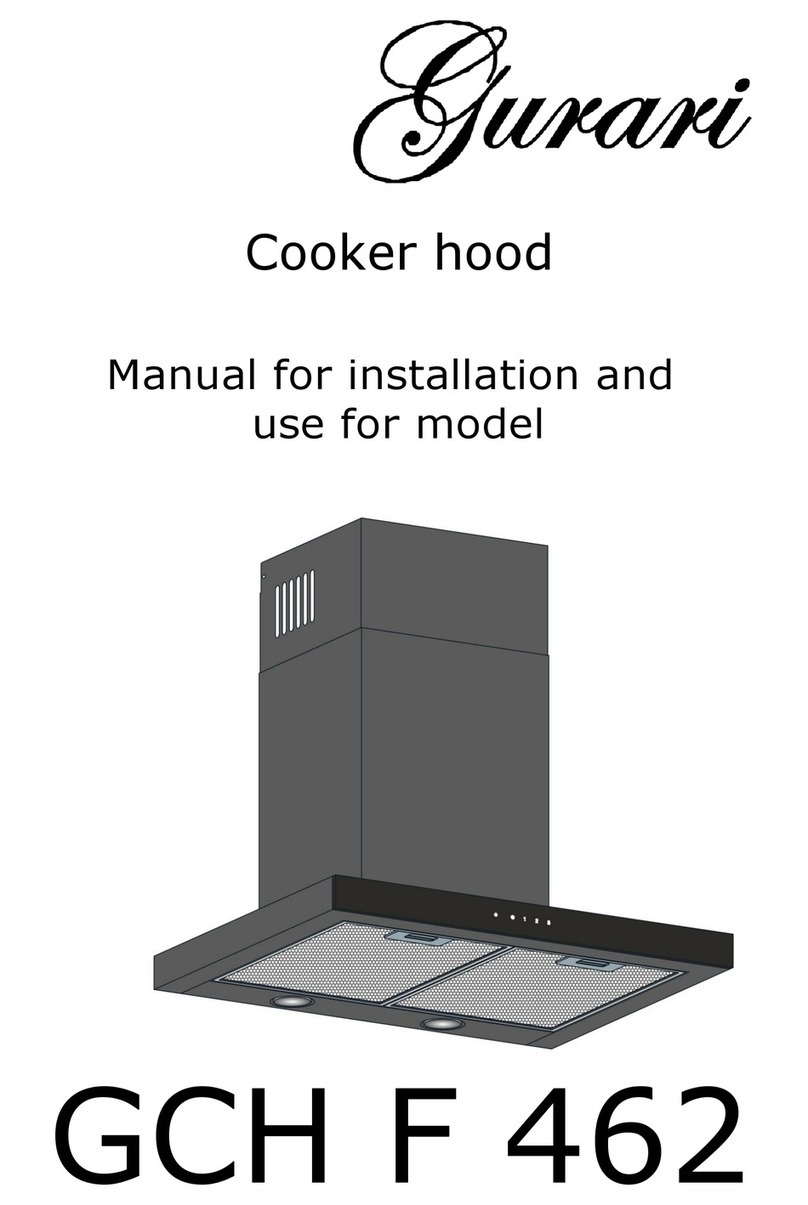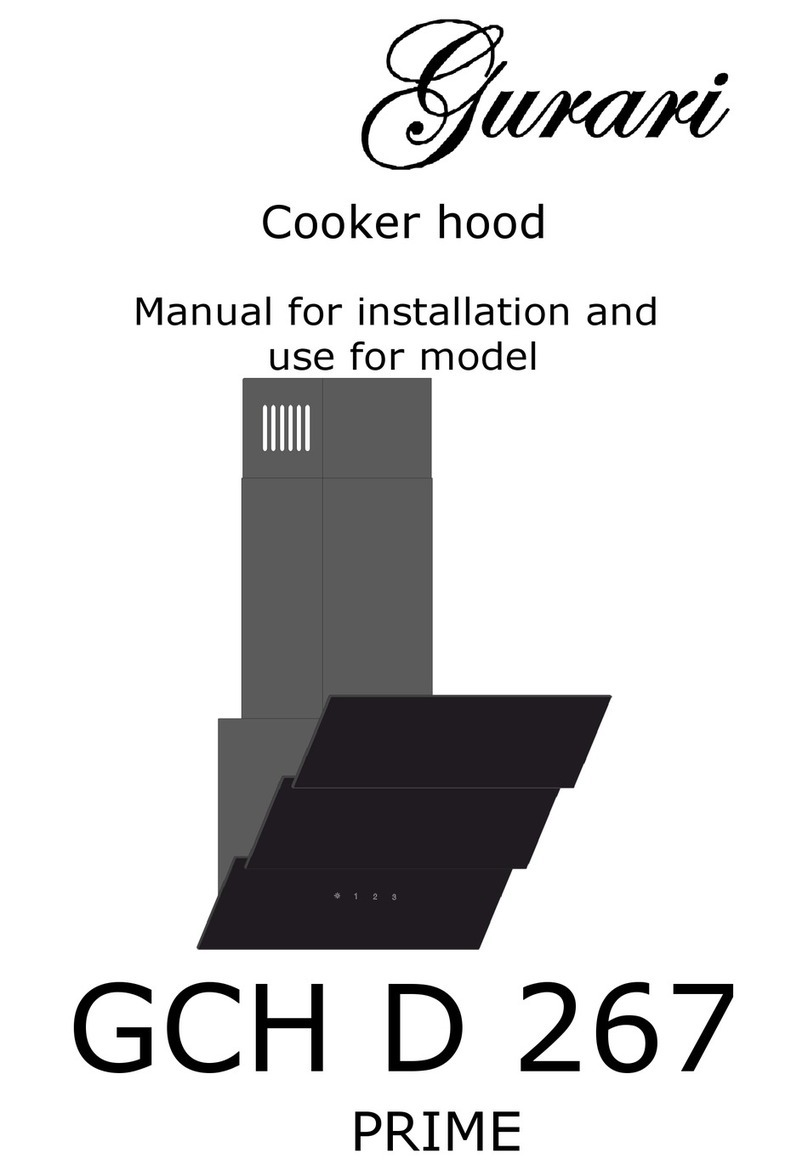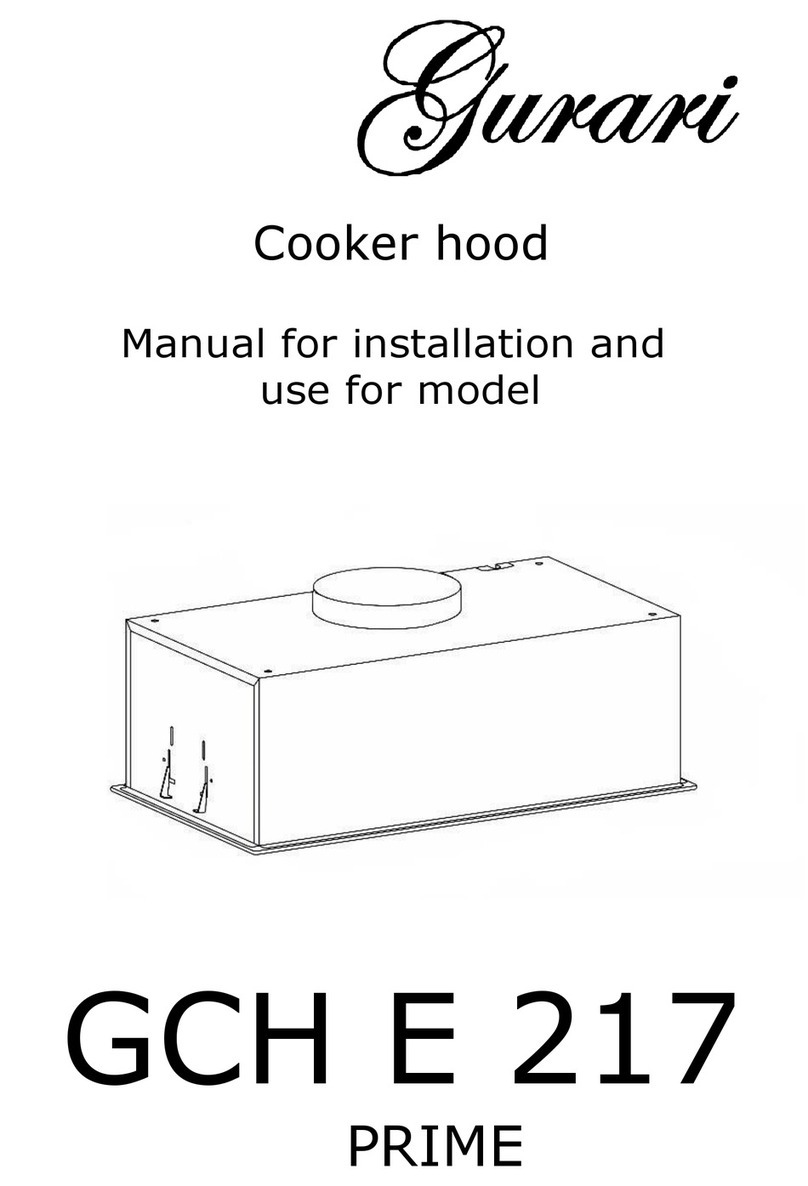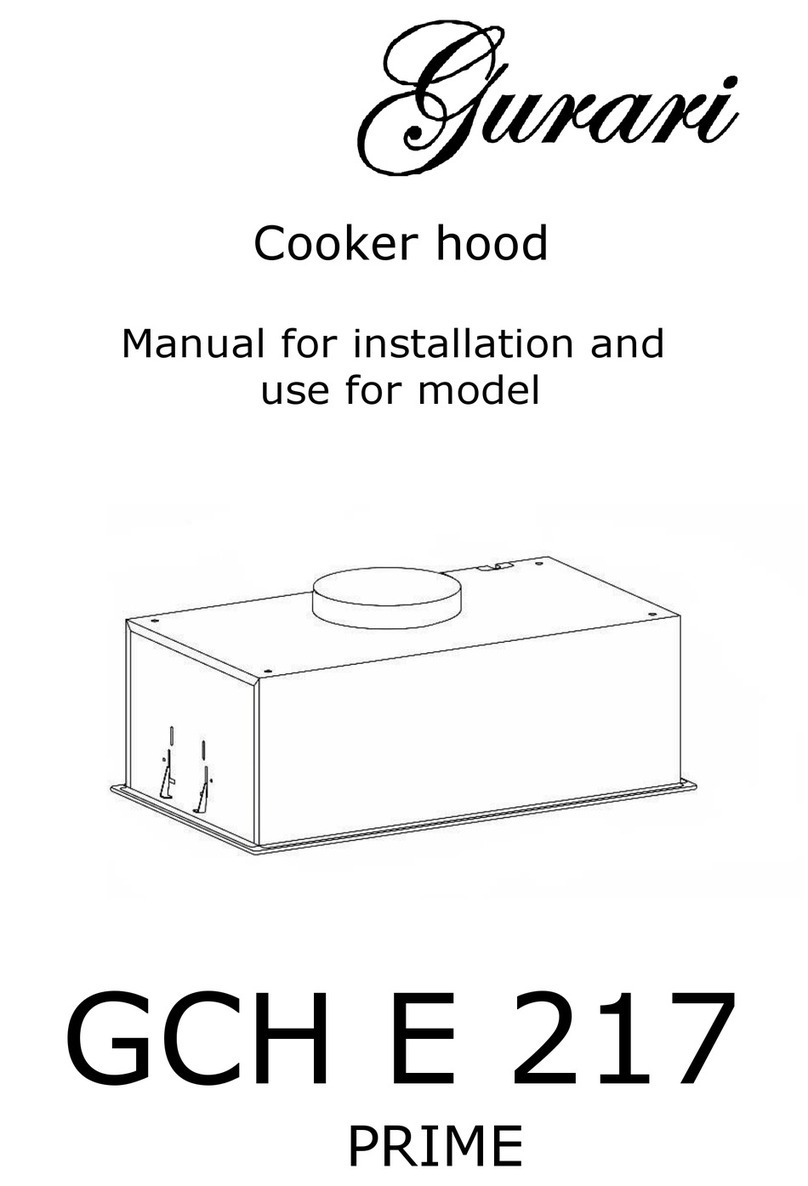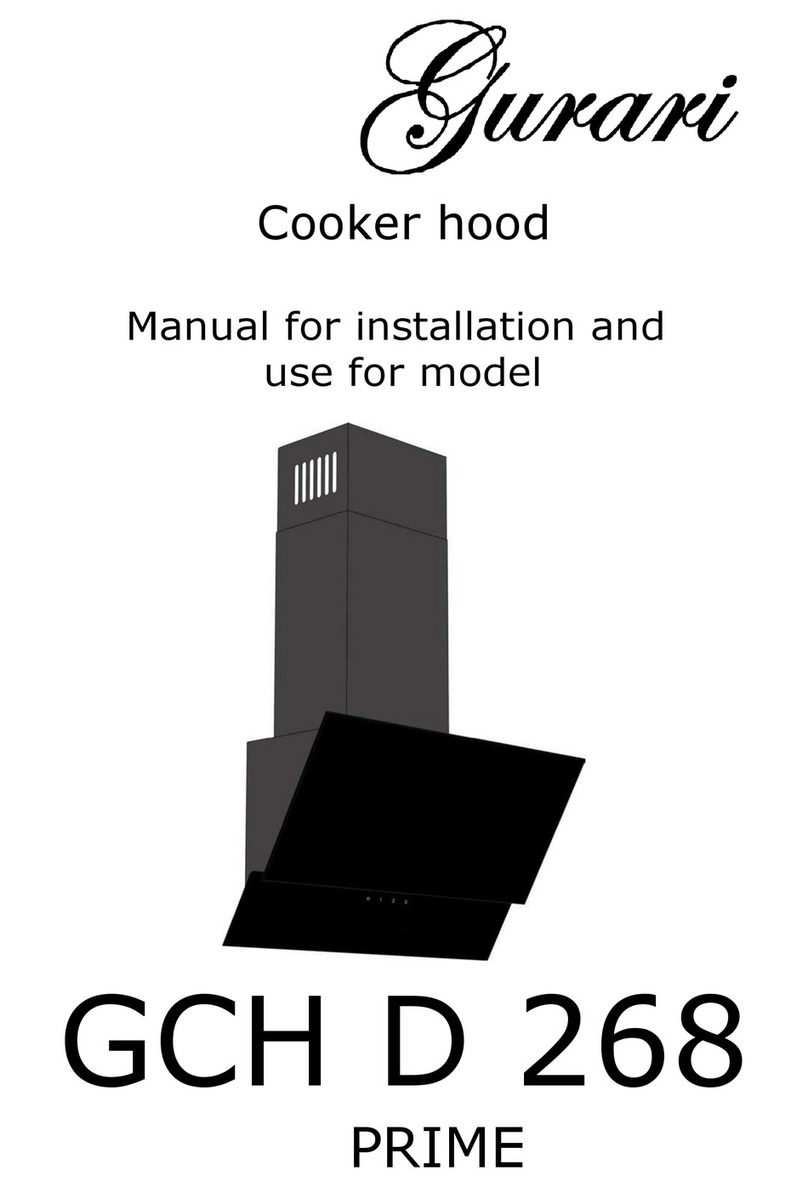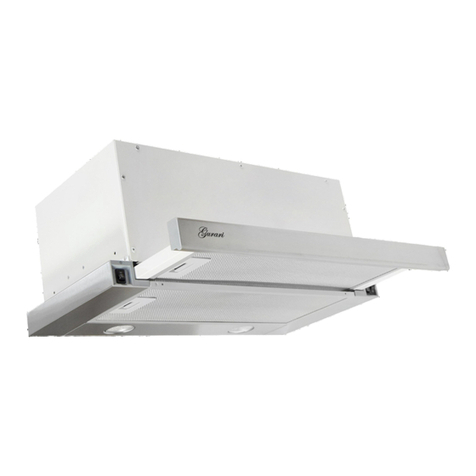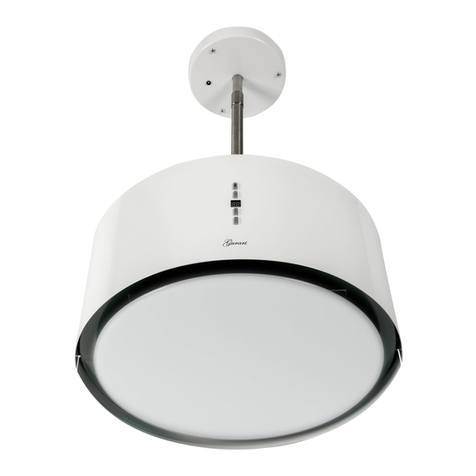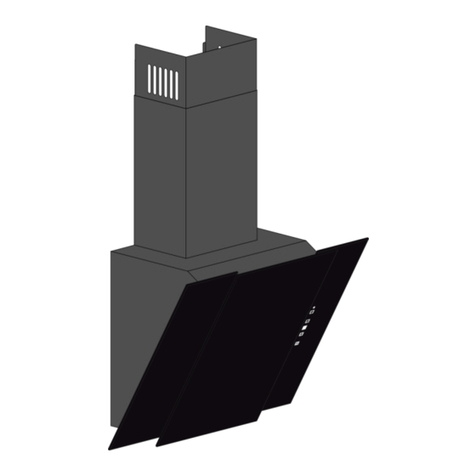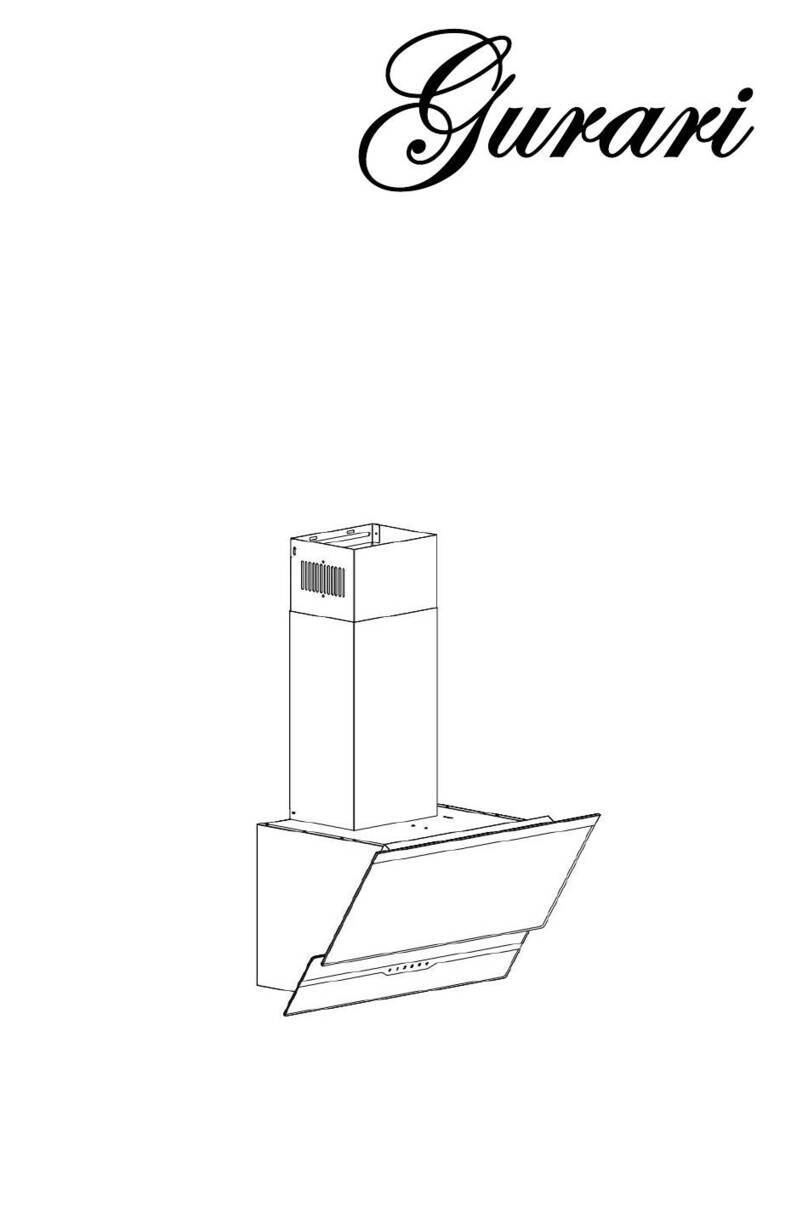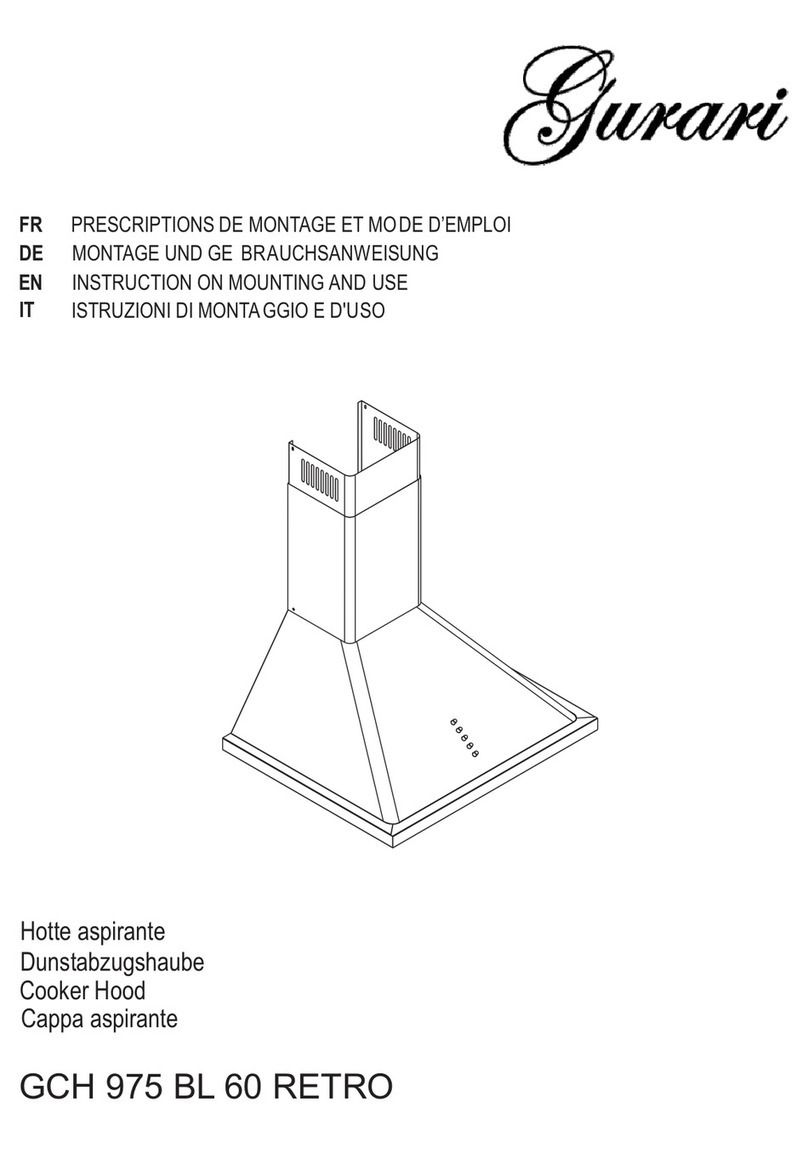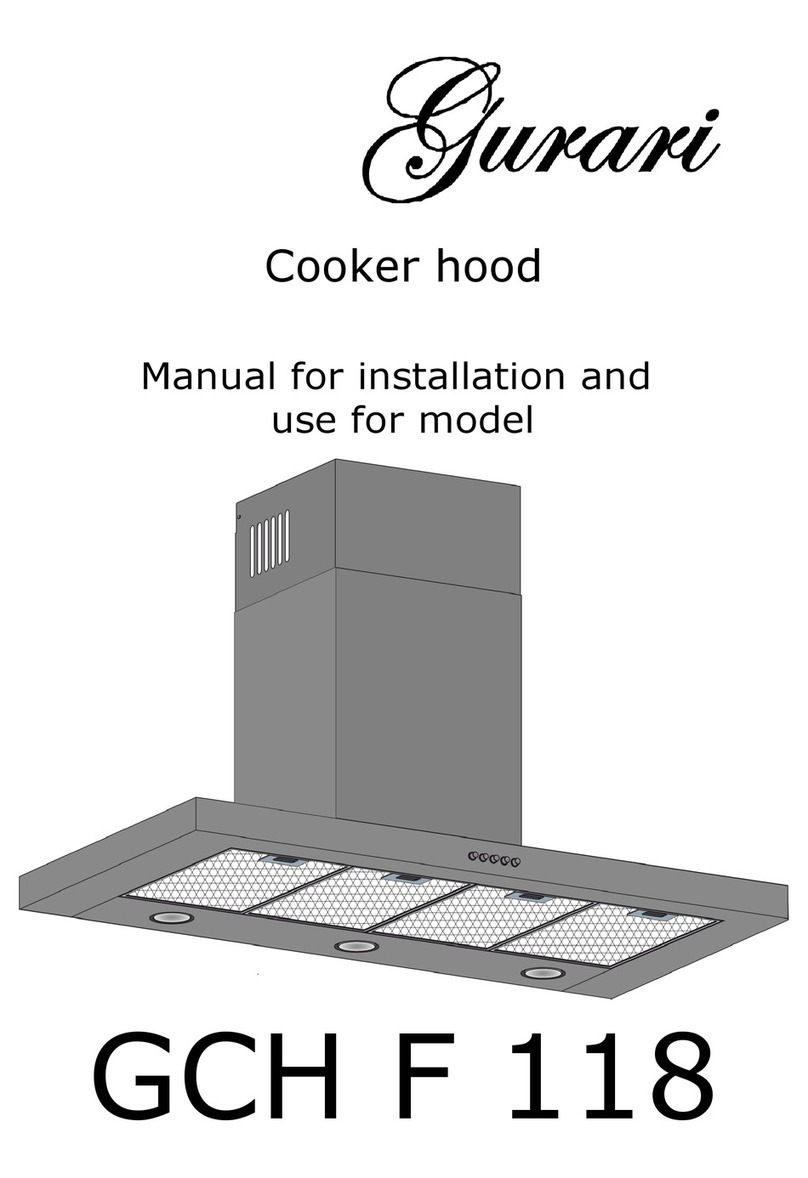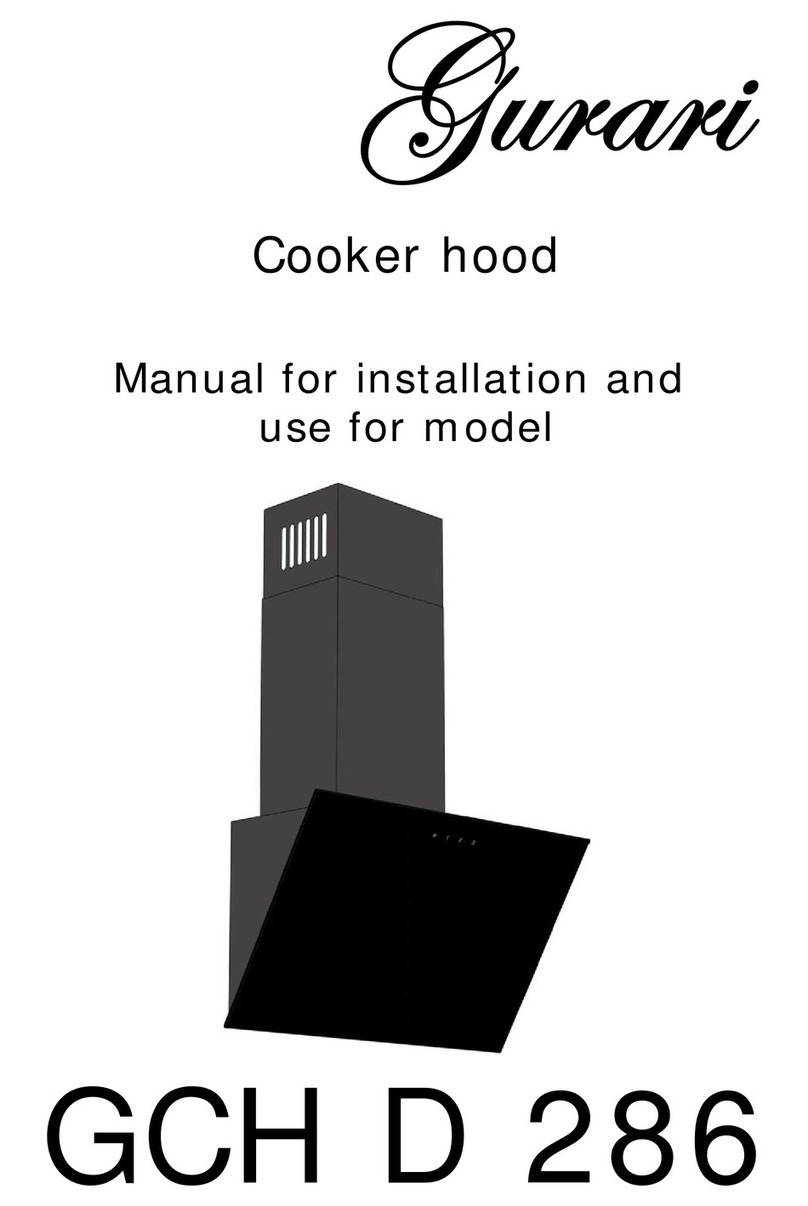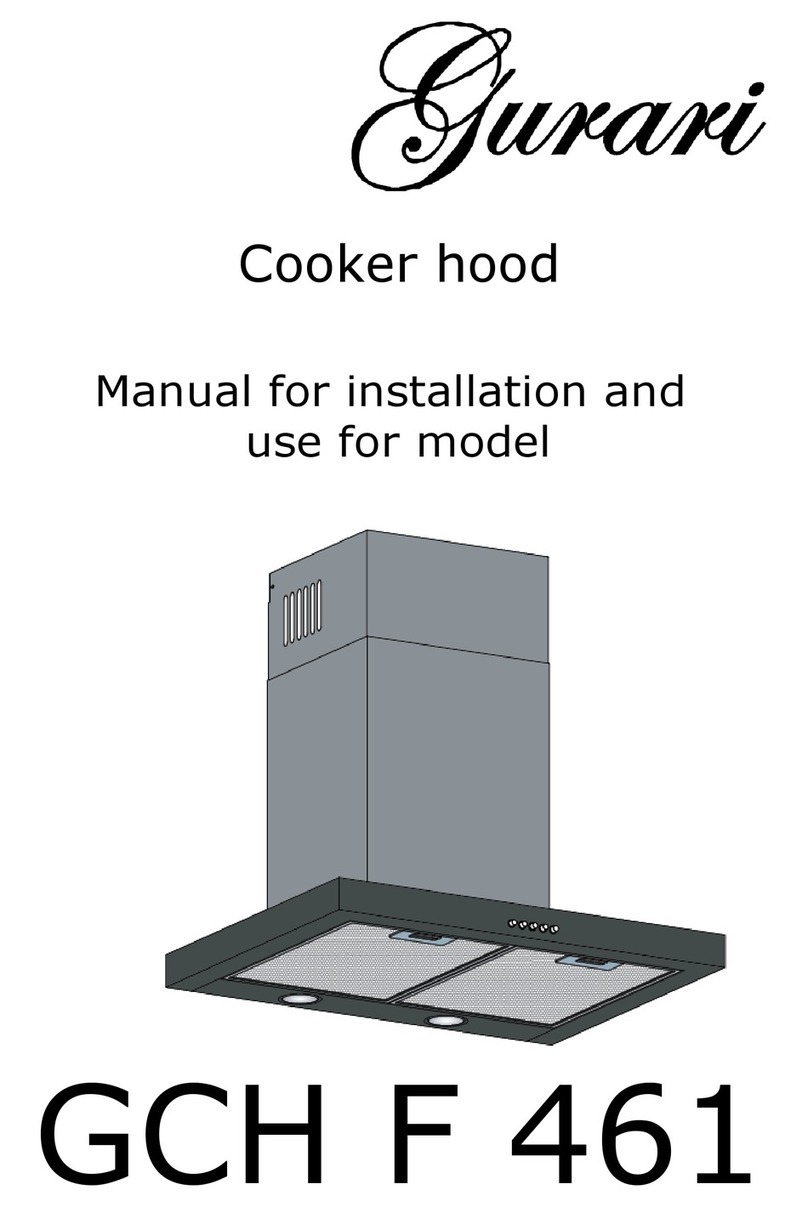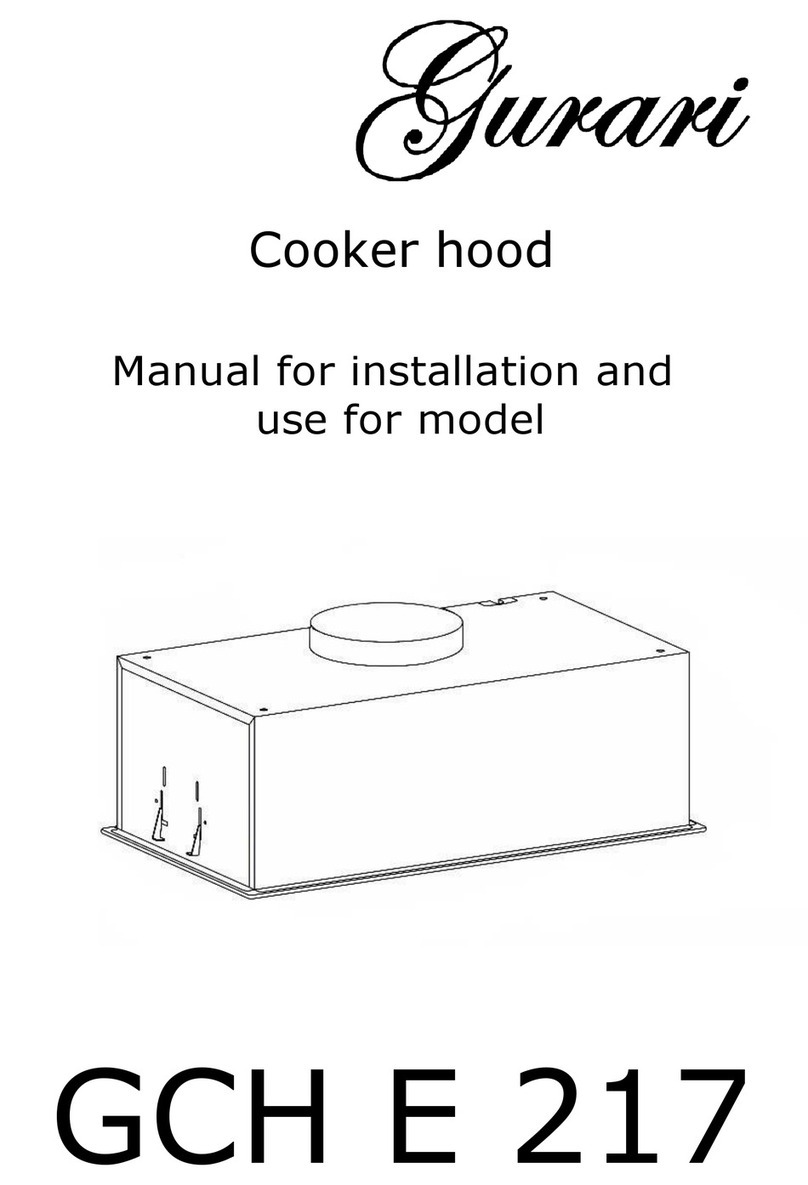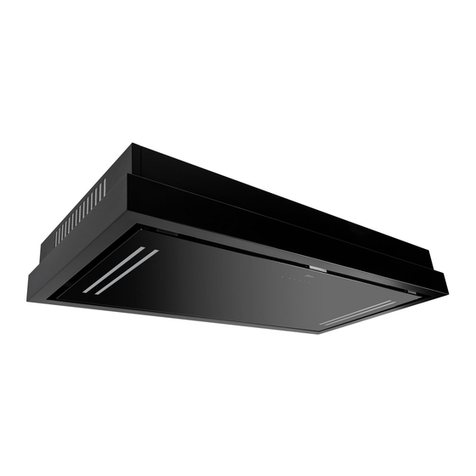
Für alle Abluft-Führungen sind generell die behördlichen Vorschriften einzuhalten. Wird die Dunst-
haube mit Abluft betrieben, ist für eine ausreichende Luftzufuhr zu sorgen.
Der gemeinsame Betrieb von Dunstabzugshauben und kamingebundenen Feuerungsstätten wie
Gasthermen und Öl- oder Kohleöfen im selben Raum, unterliegt aufgrund Länder-Bauvorschriften
bestimmten Einschränkungen.
Wir empfehlen im Zweifelsfall den Rat und die Zustimmung des Bezirksschornsteinfegers oder der
örtlichen Baubehörde einzuholen.
Mindestabstände
Abstand zum Elektro-Kochfeld
Von der Elektrokochstelle bis zur Unterkante des Haubenkorpus sollte
ein Mindestabstand von 600mm eingehalten werden.
Abstand zum Gas-Kochfeld
Zwischen Gaskochstellen (Oberkante Topfträger) und Unterkante
Haubenkorpus sollten Sie einen Mindestabstand von 700mm
einhalten.
Sonstige Hinweise
Es muss darauf geachtet werden, dass im Betrieb befindliche Kochstellen stets abgedeckt sind, damit
durch starke Hitzeentwicklung das Gerät nicht beschädigt wird.
Beim Frittieren unterhalb einer Dunstabzugshaube ist das zum Frittieren verwendete Gerät während
des Betriebs zu beaufsichtigen.
In Fritteusen enthaltene Öle können sich durch Überhitzung selbst entzünden. Wird verschmutztes Öl
verwendet kann es noch leichter zur Selbstentzündung kommen.
Wir weisen darauf hin, dass durch Überhitzung ein Brand entstehen kann. Desweiteren weisen wir
ausdrücklich darauf hin, dass das Flambieren unter der Dunsthaube nicht erlaubt ist.
Bei allen Arbeiten an der Dunstabzugshaube, auch beim Lampenwechsel, ist die Dunsthaube stromlos
zu machen (Sicherungsautomaten abschalten bzw. Schraubsicherung aus der Fassung heraus-
nehmen). Außerdem ist es wichtig die Filterwechsel- und Reinigungsintervalle einzuhalten.
Bei Nichtbeachtung besteht aufgrund von Fettablagerungen akute Feuergefahr!
Energiesparhinweise
Zubereitung, aufwärmen und warmhalten von Speisen sollte immer in Töpfen oder Pfannen mit
geschlossenen Deckeln erfolgen.
Das Gerät sollte umgehend nach Kochende ausgeschaltet oder, wenn vorhanden, die zeitverzögerte
Abschaltfunktion in Anspruch genommen werden.
Die Beleuchtung des Geräts sollte nach dem Kochende ausgeschaltet werden.
Topfgrößen sollten an den Durchmesser der verwendeten Kochzonen angepasst sein.
Verwenden Sie die höchste Motorgeschwindigkeit des Gerätes nur bei einer hohen Konzentration von
Kochdünsten.
Zur Steigerung der Effizienz des Geräts, reinigen Sie regelmäßig die Fettfilter.
Kohlefilter (bei Verwendung im Umluftbetrieb) sollten nach Herstellervorgaben regelmäßig
ausgetauscht werden.
Technische Daten
Leistung
- Anschlusswert in Watt 168W
- Davon Beleuchtung (LED) 2x 1,5W
- Spannung in Volt 220-240V
- Fördervolumen max. 1000m³/h
Maße
- Höhe in cm 70,5-110,5cm
- Breite in cm 60cm
- Tiefe in cm 43,3cm
- Abluftöffnung in mm ø150mm
- Nettogewicht in kg 12kg
Ausstattung
- Anschluss mit Schukostecker
- 3-stufige Steuerung
- LED-Beleuchtung (2x 1,5W)
- Fettfilter (spülmaschinengeeignet)
- Geeignet für Um- und Abluft
Sicherheitshinweise
Spannungsversorgung
Der Anschluss erfolgt über eine fest montierte Zuleitung mit Schutzkontaktstecker.
Im Falle eines erforderlichen Festanschlusses darf die Dunsthaube nur durch einen beim zuständigen
EVU (Elektrizitätsversorgungsunternehmen) eingetragenen Elektroinstallateur angeschlossen werden.
Installationsseitig ist eine Trennvorrichtung (dazu zählen Sicherungen, Schütze und LS-Schalter gem.
VDE 0730, §7, Teil 1) vorzusehen.
Abluftanschluss
Um einen optimalen Betrieb bei Abluft zu gewährleisten, empfehlen wir die Umsetzung folgender
Maßnahmen
- Kurze, gerade Rohrführung
- Möglichst wenige Rohrbögen
- Verlegung der Rohre in flachen Bögen und Vermeidung von spitzen Winkeln
- Möglichst großer Rohrdurchmesser
Im Falle einer Nichtbeachtung dieser Punkte kann es zu drastischen Leistungsverlusten und erhöhten
Betriebsgeräuschen kommen. Dies ist nicht als Fehlfunktion des Gerätes zu werten.
Außerdem ist es in jedem Fall unzulässig die Abluft in anderweitig genutzte Schornsteine, Abzüge
oder sonstige Luftkanäle zu leiten, es sei denn diese werden ausschließlich für die Abluft der Dunst-
abzugshaube verwendet.
Wir empfehlen bei Einleitung der Abluft in einen nicht in Betrieb befindlichen Kamin, die Zustimmung
des zuständigen Schornsteinfegers einzuholen.
Teilebezeichnung
Die Dunstabzugshaube besteht aus folgenden Teilen
Maßskizzen
Montage
1. Prüfung
Vor Beginn der eigentlichen Montage sollte das Gerät geprüft werden. Neben der Kontrolle äußerlich
erkennbarer Schäden ist auch eine Funktionskontrolle durchzuführen. Hierzu ist das Gerät aus der
Verpackung zu nehmen, von allen Verpackungsmaterialien zu befreien und mit der Rückseite auf den
Boden/Tisch zu legen. Nach Verbindung mit einer Stromversorgung kann nun die Beleuchtung als
auch die Funktion der einzelnen Stufen überprüft werden.
2. Vermessung
Die maßgebliche Wandhalterung befindet sich hinter dem Luftauslass an der Oberkante der Rückwand
des Gerätes. Der Abstand zwischen den hier vorhandenen Öffnungen muss abgenommen und in
gleicher Weise auf die Wand übertragen werden. Dabei ist immer von der Mitte des Kochfeldes
auszugehen und der hälftige Abstand von dort jeweils nach rechts und links zu übertragen.
Die Höhe ist von mehreren Komponenten abhängig. So kann beispielsweise ein vorhandener Fliesen-
spiegel aber auch die Gesamthöhe der Küche Einfluss auf den Abstand der Haube zum Kochfeld
nehmen. Soll der mitgelieferte Kamin bis zur Decke reichen, so kann die Haube nicht tiefer gehängt
werden als der komplett ausgezogene Teleskopkamin dies zulässt. Der vorgenannte Mindestabstand
ist hierbei in jedem Fall zu berücksichtigen. Auch ein höherer Fliesenspiegel als der vorgenannte
Mindestabstand kann eine höhere Positionierung an der Wand notwendig machen. Insofern kann die
Höhe erst anhand der örtlichen Gegebenheiten abschließend festgelegt werden.
Gehen Sie bei der Vermessung erst einmal vom Mindestabstand aus. Muss die Haube aufgrund
anderer Installationen an der Wand höher gehängt werden, so ist dies grundsätzlich möglich, wir
empfehlen jedoch die Haube nicht weiter als 70cm über dem Kochfeld anzubringen (maßgeblich ist
die Unterkante der Haube). Ist die Unterkantenhöhe festgelegt, prüfen Sie ob der Kamin den Abstand
zur Decke verdecken kann. Ist dies nicht der Fall, muss auch dann die Haube evtl. höher positioniert
werden. Auch hier gilt der vorgenannte maximale Abstand. Ist Ihre Decke zu hoch, müssen Sie sich
ggfls. eine andere Lösung als Abschluss einfallen lassen. Grundsätzlich ist die Verwendung des
Kamins optional, da er lediglich der Abdeckung dient und keine für den Betrieb der Haube wichtige
technische Funktionübernimmt. Er dient lediglich optischen Zwecken.
3. Anbringung
Haben Sie die Bohrlöcher für die Halteschrauben in geeigneter Höhe und Breite eingezeichnet, so
können Sie diese nun bohren und die mitgelieferten Dübel und Schrauben eindrehen. Dabei sollten
die Schrauben fest in der Wand sitzen aber nicht komplett eingeschraubt sein. Hängen Sie nun den
Haubenkorpus an diese Schrauben und drehen diese fest.
4. Kaminmontage
Den unteren Teil des Kamins können Sie einfach auf die Haube aufsetzen. Der obere Teil wird durch
die mitgelieferte Wandschiene gehalten. Setzen Sie die Wandschiene in den oberen Kaminteil (der mit
den Schlitzen) auf Höhe der seitlichen Verschraubungen ein und nehmen Sie den Abstand der
Bohrlöcher zueinander sowie zur Oberkante des Kaminteils.
Zeichnen Sie diese Maße wiederrum mittig (Abstand zueinander) bzw. zur Decke (Abstand
Oberkante) auf der Wand ein, bohren Sie entsprechende Löcher und verschrauben Sie die
Wandhalterung an der Wand.
Sollten Sie die Haube im Abluftmodus verwenden, müssen Sie vor endgültiger Kaminmontage nun
das Abluftrohr zwischen Luftauslass der Haube und Wandanschluss der Maueröffnung installieren.
Dies setzt voraus, das sich der Mauerausgang innerhalb des durch den Kamin später verdeckten
Bereichs befindet. Ist dies nicht der Fall, muss eine Sonderkonstruktion erfolgen. Konsultieren Sie
hierzu wenn nötig einen Fachmann. Im Umluftmodus kann dieser Schritt übersprungen werden.
Verbinden Sie nun die Haube mit der Stromversorgung die sich am besten im Bereich des später
durch den Kamin verdeckten Wandbereichs befindet (auch hier empfehlen wir die Konsultation eines
Fachmannes falls dies nicht der Fall ist). Schieben Sie die beiden Kaminteile ineinander und
verschrauben das obere mit der Wandhalterung. Lassen Sie nun den unteren Teil nach unten auf die
Haube gleiten. Damit ist die Montage abgeschlossen.
Betrieb
Einsetzen und Wechsel der Kohlefilter
Für den Umluftbetrieb empfehlen wir die Verwendung eines
Kohlefilters, der die Kochdünste vom Geruch befreit. Der Kohlefilter
besteht aus zwei mit Aktivkohle gefüllten Kassetten, die links und
rechts auf die Ansaugöffnungen des Motors aufgesetzt und
eingedreht werden (s. Abb.)
Um die Aktivkohlefilter zu montieren gehen Sie bitte
folgendermaßen vor:
1. Entnehmen Sie zunächst die Metall-Fettfilter
2. Setzen Sie den Aktivkohlefilter auf beiden Seiten des Gebläses vor die Ansaugöffnungen
3. In der Mitte der Filter ist eine Aufnahme und auf dem Gebläse ein passender Einsatz
4. Wenn der Filter korrekt sitzt können Sie ihn mit einer kleinen Drehbewegung fixieren
5. Setzen Sie danach den Fettfilter wieder ein
Der für dieses Modell passende Kohlefilter heißt GE15
Metall-Fettfilter
Die zuvor erwähnten Fettfilter sitzen noch vor dem Motor und sorgen für die Aufnahme der fettigen
Bestandteile aus dem Küchendunst. Die Reingung kann in der Spülmaschine erfolgen und sollte alle
14 Tage (min. 1x im Monat) durchgeführt werden. Zu lange Reinigungsintervalle führen zu einer
Verstopfung des Filters und damit zu reduzierter Leistung.
Reinigung in der Spülmaschine
Die Fettfilter Ihrer Haube sind spülmaschinengeeignet (55° C). Dabei können jedoch leichte
Verfärbungen des Metalls entstehen. Diese haben keinerlei Einfluss auf die Funktion des Fettfilters
und gelten nicht als Reklamationsgrund. Legen Sie die Filter locker in die Geschirrspülmaschine ohne
sie zu biegen oder einzuklemmen. HINWEIS: Reinigen Sie sehr stark verschmutzte Fettfilter nicht
zusammen mit anderem Geschirr.
Reinigung von Hand
Bei der Handreinigung die Fettfilter zunächst ausgiebig in heißer Spüllauge einweichen, danach gut
abbürsten und vor allem sehr gut mit klarem Wasser ausspülen. Danach gut abtropfen lassen. Sehen
Sie von der Verwendung aggressiver, säure- oder laugenhaltiger Reinigungsmittel ab. Für sehr hart-
näckige Verschmutzungen können Sie auf im Handel erhältliche Fettlöser-Sprays zurückgreifen.
Bedienung
Reinigung und Pflege
- Zum Reinigen das Gerät spannungslos machen.
- Die äußeren Teile mit milder Spüllauge reinigen. Scharfe Reinigungsmittel, Bürsten, oder Scheuer-
lappen vermeiden.
- Für die Glasflächen kann herkömmlicher Glasreiniger verwendet werden.
Es ist wichtig die Filterwechsel und Reinigungsintervalle einzuhalten. Bei Nichtbeachtung
kann in Folge von Fettablagerung Feuergefahr bestehen.
Entsorgung der Transportverpackung
Die Verpackung schützt das Gerät vor Transportschäden. Die Verpackungsmaterialien sind nach
umweltverträglichen und entsorgungstechnischen Gesichtspunkten ausgewählt und deshalb recycel-
bar. Die Rückführung der Verpackung in den Materialkreislauf spart Rohstoffe und verringert das
Abfallaufkommen. Ihr Fachhändler nimmt die Verpackung zurück.
Verpackungsteile (z.B. Folien, Styropor) können für Kinder gefährlich sein. Es besteht Erstickungsge-
fahr! Bewahren Sie Verpackungsteile außerhalb der Reichweite von Kindern auf und entsorgen Sie
diese so schnell wie möglich.
Entsorgung des Altgerätes
Elektrische und elektronische Altgeräte enthalten vielfach noch wertvolle Materialien.
Sie enthalten aber auch schädliche Stoffe, die für ihre Funktion und Sicherheit
notwendig waren. Im Restmüll oder bei falscher Behandlung können diese der
menschlichen Gesundheit und der Umwelt schaden. Geben Sie Ihr Altgerät deshalb
auf keinen Fall in den Restmüll. Nutzen Sie stattdessen die von Ihrer Gemeinde oder
Kommune eingerichtete Sammelstelle zur Rückgabe und Verwertung
elektrischer und elektronischer Altgeräte.
Service
Bei eventuellen Fragen und Störungen wenden Sie sich bitte an unseren Kundendienst.
BIB Handelshaus GmbH
Gremberger Str. 18
51105 Köln
Tel.: 036602 473898
MO - FR von 8:30 - 16:30
Halten Sie bitte die Seriennummer und die Modellbezeichnung des Gerätes bereit. Die Seriennummer
finden Sie nach Entnehmen der Metallfilters an der Innenseite des Gerätes.
Alle Angaben vorbehaltlich Konstruktionsänderungen im Rahmen der technischen Weiterentwicklung
unserer Produkte.
© 2023 BIB Handelshaus GmbH
An/Aus Schaltet den Motor an und aus
Schaltet die Beleuchtung an und aus
Aktiviert den Timer und schaltet die
Dunstabzugshaube nach 3min aus
Wählt Leistungsstufe 1 aus
Wählt Leistungsstufe 2 aus
Wählt Leistungsstufe 3 aus
Leistungsstufe 1
Leistungsstufe 2
Leistungsstufe 3
Beleuchtung
Timer
